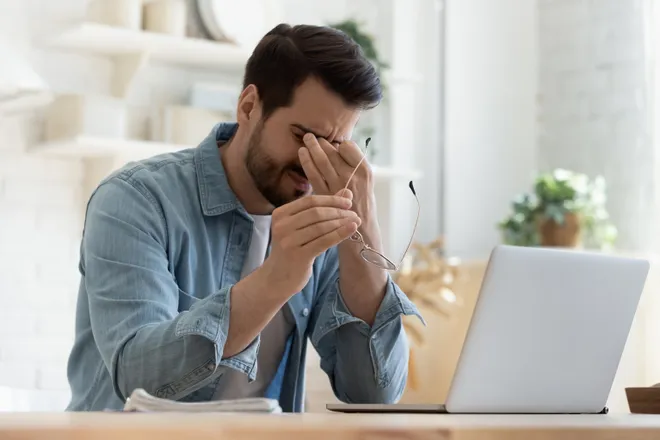Does driving or grocery shopping make you anxious? Your eyes may be the problem.
Driving a car is a lot like grocery shopping: bright lights, a dizzying amount of decisions to make and constant swerves around people on a mission. It's a sensory overload that can be anxiety-inducing for some people.
Now, imagine if a pair of glasses or a simple, affordable correction to your existing lenses could ease that stress, allowing you to feel at ease while on the road or navigating a busy store.
It may sound too good to be true, but for those who have binocular vision dysfunction (BVD), it’s a potential fix that optometrists say could not only relieve anxiety, but also headaches, dizziness, difficulty reading, blurry vision and more.
BVD is having a moment on TikTok, with its hashtag amassing more than 267 million views. One user said that she met with several doctors to understand her symptoms, but none of them had any answers. It wasn’t until she saw videos by David Antonyan, an optometrist with Vivid Visions Optometry in Valencia, California, on the topic that she visited a BVD specialist and received a diagnosis.
Since her glasses were corrected, she said she now feels safer while driving, can see more details in movies, has less anxiety and a longer attention span, according to a video she posted with over 4,000 comments from others sharing similar stories.

Antonyan learned he had problems with his binocular vision in 2016 after asking the specialist he was working with in a BVD clinic during optometry school to test him for the condition. After Antonyan had his glasses tweaked, many of his symptoms, including anxiety, headaches and difficulty concentrating, resolved.
“It was my vision all along, and all of my own eye doctors missed it,” Antonyan said. “Correcting my BVD has changed my life completely and given me the opportunity to help others who have suffered from this for most of their lives and haven't been able to get the help they need.”
Ophthalmologists — eye doctors who perform medical and surgical treatments — however, are skeptical. Those who spoke to USA TODAY say that there isn’t enough scientific evidence to support claims that BVD causes symptoms like anxiety or that a lens correction can resolve them. Others argue that the simple fix of a lens adjustment is worth a try.
Here’s what’s known about BVD, according to research and eye care providers’ experiences with patients.
What is BVD?
BVD is an umbrella term mostly used by optometrists (the eye care providers that test and correct your vision) that includes several conditions involving eye misalignment, meaning the eyes struggle to work together and point in different directions. Some of the conditions include convergence insufficiency and hyperphoria.
This misalignment, which isn't noticeable in a mirror, sends confusing messages to your brain about your surroundings, interfering with depth perception, 3D vision and peripheral vision, Antonyan said.
You can have BVD even if you have perfect vision, experts say. Studiessuggest that about 20-30% of the general population may have it, according to Jacqueline Theis, an optometrist who specializes in neuro-optometry at the Concussion Care Centre of Virginia.
What are symptoms of BVD?
BVD can cause a variety of symptoms that can make simple tasks difficult, according to research reviews, case reports and optometrists’ patient interactions.
Some of those include:
- Eye pain
- Double vision
- Poor depth perception
- Anxiety
- Frequent headaches
- Balance problems
- Difficulty concentrating
- Dizziness
- Reading fatigue
- Bumping into walls while walking
- Nausea
- Frequent eye squinting
Because these symptoms overlap with many other health conditions, experts say it’s important to tell all of your doctors how you feel so they can rule out other health conditions.
Does BVD really cause anxiety?

Grocery stores are brightly lit, crowded and loaded with hundreds of colorful products on tall shelves at varying levels, all of which can overwhelm your visual system, and by default, your brain, Antonyan said.
Your nervous system is responsible for turning light that hits your eyes into electrical signals that travel to your brain, where they are turned into the images you see. When you have BVD and are swamped with visual stimuli, this system stresses out, triggering a fight or flight response in an attempt to bring stability, according to Antonyan.
“It's your body's way of shutting things down and getting you to a safe place,” he said.
For example, it may be hard to navigate around shelves and other shoppers if you have poor depth perception, making you disoriented and anxious; or it can be overwhelming to reach for products and read ingredient labels if you have double vision because your eyes struggle to decipher between two images.
The same overstimulation can happen in a car (whether you’re a driver or passenger), especially at night or when it's raining, or in busy environments like clubs, concerts and parties, Antonyan said.
Joshua Watt, an optometrist in Colorado and vision therapy task force member with the American Optometric Association, said our visual system “contributes significantly to our emotional state,” so if it’s not working properly, “it can cause our sense of balance and stability to be disrupted and make us not feel safe in our environment.”
Dr. Jane Edmond, a neuro-ophthalmologist and director of the Mitchel and Shannon Wong Eye Institute at the Dell Medical School in Texas, agrees that poor depth perception can cause anxiety, especially when driving or playing sports like football; however, she doesn’t think there’s enough evidence to say that BVD causes anxiety.
What causes BVD?
Some people can be born with BVD while others can develop it over time, either because of improper development as a baby or age.
Your brain establishes connections with your eyes after birth, Theis said, so babies born early, or children who aren’t exposed to the appropriate visual stimuli during their first years of life, are more likely to develop BVD.
Concussions, stroke, traumatic brain injuries and neurologic diseases such as Parkinson’s can also cause BVD, as well as certain infections such as shingles or herpes zoster, according to Dr. Rebecca Leenheer, a pediatric ophthalmologist and spokesperson for the American Academy of Ophthalmology. Hormonal changes associated with menopause, pregnancy or thyroid disease may lead to BVD, as hormones affect eyes and the muscles that control them.
BVD is also associated with certain neurodevelopmental conditions such as autism and ADHD, Antonyan said.
How do you fix BVD?
Because many conditions fit under the BVD umbrella, there’s no one-size-fits-all treatment, Watt said.
The most common treatment, according to optometrists, is adding prisms to a person’s glasses, which bend incoming light to help both eyes see the same image. Prisms may offer short- or long-term relief, Watt said.
Depending on the lab that makes them, prisms cost about $10 per eye, Antonyan said. The downside: they can’t be added to contact lenses.
Ophthalmologists say that research supports the use of prisms mostly to correct double vision. Some retrospective studies on people who had concussions and traumatic brain injuries found that prisms helped alleviate symptoms such as headaches, dizziness and anxiety.
In other cases, optometrists can tweak your prescription or suggest vision therapy to train your eyes to work together. Ophthalmologists, however, caution against therapy because the research on its ability to treat BVD at large isn’t strong — and it’s expensive, Edmond said.
What can I do if I think I have BVD?

Visit your eye care provider if you think you have BVD, experts suggest; they might refer you to a specialist for additional testing that will measure your eye posture, depth perception, reading ability, balance and more. Antonyan said this test can take about an hour.
Finding a specialist is easier said than done. Not many exist and most are scattered across the U.S., experts say. Antonyan recommends using specific keywords such as “binocular vision specialist, neuro-optometrist and behavioral optometrist” during your search for an eye care provider near you who can test for BVD.
Edmond recommends also seeing your primary care or other doctors to address symptoms that are unrelated to your eyes.
Above all, don’t be afraid to “voice your concerns, ask questions and keep looking for answers,” Watt said: “There are solutions to these problems, and you don’t have to live the rest of your life suffering.”
Disclaimer: The copyright of this article belongs to the original author. Reposting this article is solely for the purpose of information dissemination and does not constitute any investment advice. If there is any infringement, please contact us immediately. We will make corrections or deletions as necessary. Thank you.







